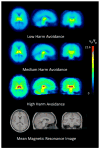A positive relationship between harm avoidance and brain nicotinic acetylcholine receptor availability
- PMID: 24148908
- PMCID: PMC3851586
- DOI: 10.1016/j.pscychresns.2013.07.010
A positive relationship between harm avoidance and brain nicotinic acetylcholine receptor availability
Abstract
Prior research indicates that disturbance of cholinergic neurotransmission reduces anxiety, leading to the hypothesis that people with heightened cholinergic function have a greater tendency toward anxiety-like and/or harm-avoidant behavior. We sought to determine if people with elevated levels of harm avoidance (HA), a dimension of temperament from the Temperament and Character Inventory (TCI), have high α4β2* nicotinic acetylcholine receptor (nAChR) availability. Healthy adults (n=105; 47 non-smokers and 58 smokers) underwent bolus-plus-continuous infusion positron emission tomography (PET) scanning using the radiotracer 2-[18F]fluoro-3-(2(S)azetidinylmethoxy) pyridine (abbreviated as 2-FA). During the uptake period of 2-FA, participants completed the TCI. The central study analysis revealed a significant association between total HA and mean nAChR availability, with higher total HA scores being linked with greater nAChR availability. In examining HA subscales, both 'Fear of Uncertainty' and 'Fatigability' were significant, based on higher levels of these characteristics being associated with greater nAChR availabilities. This study adds to a growing body of knowledge concerning the biological basis of personality and may prove useful in understanding the pathophysiology of psychiatric disorders (such as anxiety disorders) that have similar characteristics to HA. Study findings may indicate that heightened cholinergic neurotransmission is associated with increased anxiety-like traits.
Keywords: Harm avoidance; Nicotine dependence; Nicotinic acetylcholine receptor; Positron emission tomography; Temperament and Character Inventory; Tobacco.
Published by Elsevier Ireland Ltd.
Conflict of interest statement
The authors report no biomedical financial disclosures or potential conflicts of interest.
Figures


References
-
- Ampollini P, Marchesi C, Signifredi R, Ghinaglia E, Scardovi F, Codeluppi S, Maggini C. Temperament and personality features in patients with major depression, panic disorder and mixed conditions. Journal of Affective Disorders. 1999;52:203–207. - PubMed
-
- Arneric SP, Sullivan JP, Briggs CA, Donnelly-Roberts D, Anderson DJ, Raszkiewicz JL, Hughes ML, Cadman ED, Adams P, Garvey DS, Wasicak JT, Williams M. (S)-3-methyl-5-(l-methyl-2-pyrrolidinyl) isoxazole (ABT 418): a novel cholinergic ligand with cognition-enhancing and anxiolytic activities: I. In vitro characterization. Journal of Pharmacology and Experimental Therapeutics. 1994;270:310–318. - PubMed
-
- Bailer UF, Price JC, Meltzer CC, Mathis CA, Frank GK, Weissfeld L, McConaha CW, Henry SE, Brooks-Achenbach S, Barbarich NC, Kaye WH. Altered 5-HT(2A) receptor binding after recovery from bulimia-type anorexia nervosa: relationships to harm avoidance and drive for thinness. Neuropsychopharmacology. 2004;29:1143–1155. - PMC - PubMed
-
- Ball S, Smolin J, Shekhar A. A psychobiological approach to personality: examination within anxious outpatients. Journal of Psychiatric Research. 2002;36:97–103. - PubMed
Publication types
MeSH terms
Substances
Grants and funding
LinkOut - more resources
Full Text Sources
Other Literature Sources
Medical

